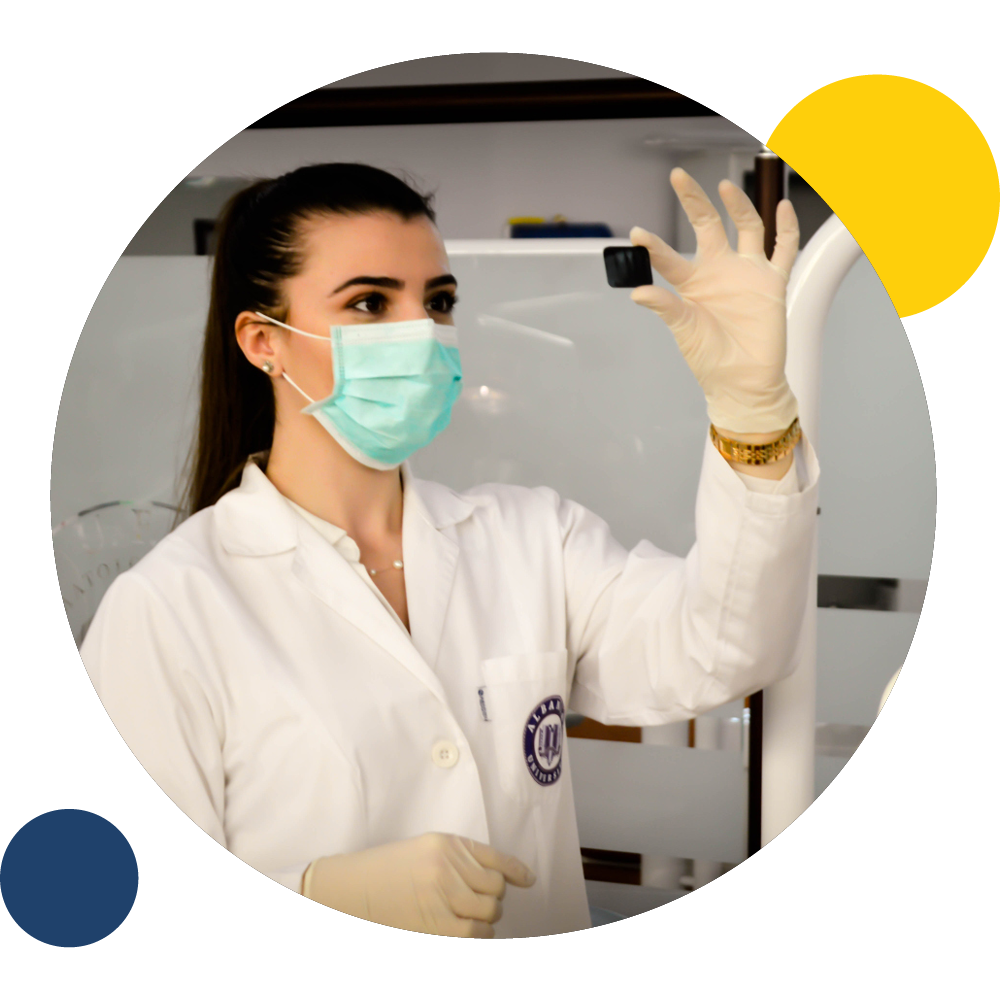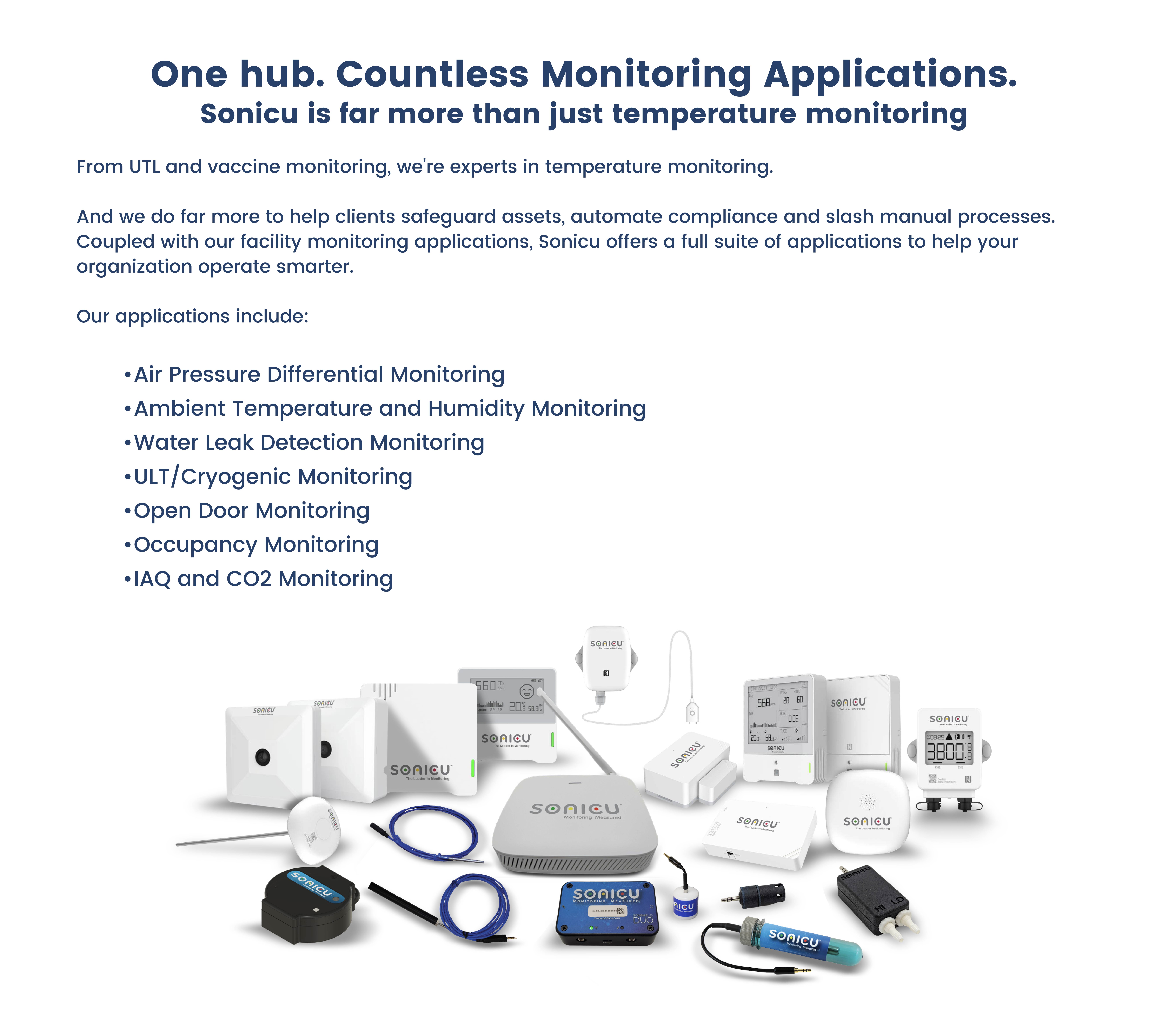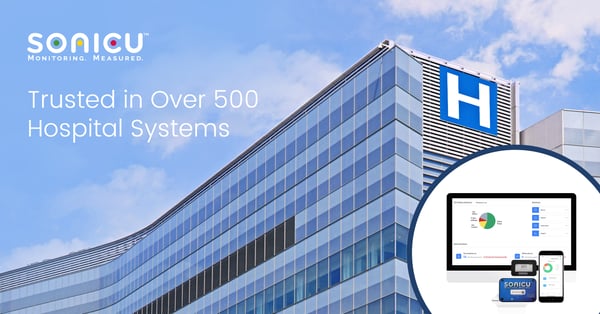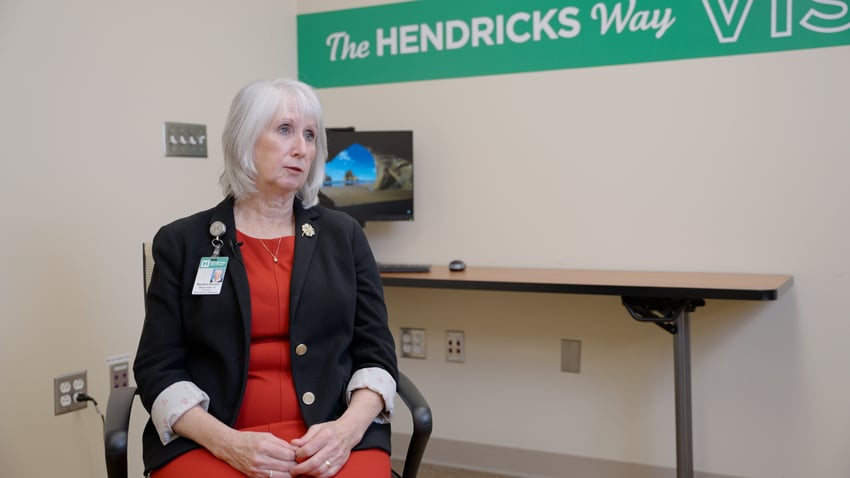Healthcare Compliance Monitoring
If you are looking for healthcare compliance monitoring equipment that helps you and your team eliminate manual logging, improve compliance readiness, and protect all your temperature-sensitive assets, you’ve arrived at the right place.

Let us help you evaluate your needs!
- Safety: Alerts via text, email, push notifications and phone calls to protect your precious assets
- Compliance: Automated compliance reports
- Efficiency: Reduced Manual Logging and time spent on reports
And what makes us different?
- Lifetime Warranty: Never buy hardware again!
- Unlimited Users: Scale across your entire organization
- Connectivity Flexibility: Wi-Fi, Cellular or Data Hub
- Phone call alarms: Alerts won't get ignored
- Mobile App: 500 Freezers in your pocket
- Facility monitoring: Simple to add water leak, door open, occupancy, and even IAQ monitoring
Engineered in Indiana with U.S.-based support.

Healthcare Monitoring
From the operating room to the cafeteria freezer, risks of a broken freezer or compromised clean room can range from the loss of tens of thousands of dollars in inventory to adverse patient outcomes.
Healthcare Brochure
See What Customers Say About Sonicu
Asset Protection. Compliance Automation. And Reduced Manual Processes.
Sonicu serves thousands of professionals at hundreds of organizations across North America by improving how they monitor and manage their most sensitive assets and environments.
Professionals from healthcare, life science, laboratory and cold chain facility management turn to Sonicu to help them improve the way they do business.

How IU Health
consolidated all of its pharmacy monitoring needs
into one cloud-based platform serving dozen of locations.



Healthcare Compliance Monitoring
Some of the finest names in healthcare, including Indiana University Health, the University of Michigan Health System, and Stanford University, rely on Sonicu to provide a robust and continuous environmental monitoring system, including temperature, humidity, air pressure, and more.
These respected healthcare and research brands turn to Sonicu for four primary reasons:
- Real-Time Monitoring: the sensors collect temperature, humidity, air pressure data and more, and transmit it wirelessly to SoniCloud - our cloud-based platform.
- Operational Efficiency: Virtually eliminate the need for tedious and costly manual logging
- Compliance Automation: Respond to any regulatory audit or inspection in a few clicks with our reports section
- Asset Protection: Detect and respond to any threshold that can threaten anything perishable: food, drugs, vaccines, research, etc.
Our customers stay with us thanks to our American-based customer support, which is never more than a phone call away. While our technology is intuitive and powerful, we know it’s only as strong as the people who stand behind it.
Transform Patient Care: The Critical Role of Healthcare Compliance Monitoring in Today's Facilities
Healthcare environmental compliance monitoring in terms of temperature, humidity, air pressure, noise levels, ventilation and airflow, radiation, lighting, water quality, and air quality. It involves continuously assessing and managing these environmental parameters to ensure they meet specific standards. This is crucial for patient safety, infection control, and overall healthcare quality.
First, tracking and controlling temperature levels can help optimize patient comfort, prevent the growth of harmful microorganisms, and ensure the proper functioning of medical equipment.
Typically, hospital rooms are kept between 20°C to 24°C (68°F to 73°F), but requirements can vary based on specific areas (e.g., operating rooms, intensive care units).
Humidity regulation minimizes the risk of infection, controls the spread of airborne microbes, and prevents dehydration or overhydration of patients.
The ideal range is usually between 30% to 60% humidity, with variations depending on the facility area.
On the other hand, air pressure is another critical environmental factor to monitor in healthcare facilities, particularly for its role in infection control and maintaining clean environments in specific areas.
Positive pressure rooms are used to keep out harmful bacteria, viruses, or other contaminants. They are commonly found in operating theatres and other sterile environments like some intensive care units and pharmacies. Air pressure is higher inside the room than outside, so when the door is opened, air flows out, preventing contaminants from entering.
Negative pressure rooms, on their part, prevent the spread of infectious agents from a contaminated area to other parts of the facility. They are essential for isolation rooms for patients with airborne infections like tuberculosis or COVID-19. Air pressure is lower inside the room than outside, ensuring that air (and any contaminants) flows into the room rather than out into surrounding areas.
Also, excessive noise can affect patient recovery, increase stress levels among staff and patients, and disrupt communication. Strategies employed include soundproofing measures, monitoring of noise levels in patient care areas, and implementation of noise reduction protocols.
Additionally, proper ventilation reduces the spread of airborne diseases and controls odors. Monitoring aspects include air exchange rates, filtration effectiveness, and maintenance of HVAC systems.
Radiation safety is critical in areas where radiological procedures are performed to protect patients and staff from harmful exposure. Protocols include regular equipment checks, monitoring radiation levels, and ensuring compliance with safety guidelines.
Proper lighting is also vital for the performance of medical procedures, patient comfort, and the regulation of circadian rhythms. Monitoring aspects include intensity, quality, and distribution of light; exposure to natural light; and specialized lighting in areas like operating rooms and imaging facilities.
Monitoring water quality and plumbing ensures safe drinking water and prevents waterborne infections.
This involves regular testing for contaminants, proper maintenance of plumbing systems, and adherence to water safety standards.
On the other hand, air quality management guarantees a clean, contaminant-free environment, especially crucial in areas like operating rooms and isolation wards. Involves filtration systems, regular air changes, and maintaining specific standards for particulate matter and microbial content.
Healthcare compliance monitoring is essential in a variety of healthcare niches
To begin with, precision in environmental control is critical for sterile conditions and successful surgical outcomes.
Patients in ICUs are also particularly vulnerable, making optimal environmental conditions a priority.
In neonatal and pediatric wards, infants and children require specific temperature and humidity levels for their safety and development.
Isolation wards also need stringent air quality controls to prevent the spread of infections.
In pharmacy and laboratory areas, environmental conditions affect drug efficacy and the accuracy of laboratory tests.
The impact of healthcare compliance monitoring on day-to-day healthcare operations is immense.
It directly influences patient recovery rates, infection rates, and overall health outcomes.
It also helps healthcare facilities meet legal and ethical standards, avoiding penalties and legal issues.
Proper environmental controls can also lead to energy savings and operational cost reduction.
Healthcare compliance monitoring creates a safer and more comfortable working environment, which can improve staff efficiency and morale.
Our customers such as Exide Technologies are proud users of Sonicu’s ecosystem. Using Sonicu’s ecosystem you have access to all the products below:
- SoniLink Hub: Hardware for connectivity
- SoniShield: Hardware and Software to protect assets
- SoniCloud Platform: Our proprietary software where users interact with their instance
- Digital Sensors & Probes: Hardware (probes and sensors) in the cold/frozen environments
Lastly, it reduces the risk of healthcare-associated infections (HAIs) and other complications.
Healthcare compliance monitoring, particularly regarding temperature, humidity, air quality, and air pressure is a critical aspect of healthcare management. It ensures the safety and comfort of both patients and healthcare workers, while also meeting regulatory standards.
You can learn more about how our software helps compliance professionals in these case studies:
Problem: Pharmacy Suffered Too Much Humidity In New Wing, impacting Compounding Pharmacy
Solution: Affordable Humidity Monitoring that Delivered Powerful data to prompt contractors to fix improperly sized air handler
Problem: The dining department struck with regulatory violations
Solution: Enterprise-wide monitoring that automates regulatory compliance across all departments
Problem: Release of lead particles in battery projects
Solution: Mobile, affordable air pressure monitoring solution
What are the key components of healthcare compliance monitoring solutions?
The key components of a healthcare compliance monitoring system are multifaceted, involving various technologies and methodologies to ensure that healthcare facilities adhere to environmental standards and regulations. These components are crucial for patient safety, staff well-being, and operational efficiency.
- Sensors and monitoring devices
- Continuously measure environmental parameters like temperature, humidity, air quality, and pressure.
- Technologies used include digital thermometers, hygrometers, air quality sensors (for particulates, and CO2 levels), and pressure sensors.
- Data collection and analysis systems
- Aggregate and analyze data from sensors for real-time monitoring and historical trend analysis.
- Technologies used include data loggers, cloud computing platforms, and specialized software for data analysis and visualization.
- HVAC Systems (Heating, Ventilation, and Air Conditioning)
- Control and maintain optimal environmental conditions.
- Technologies used include advanced HVAC systems with integrated controls for temperature, humidity, and air exchange rates.
- Filtration and air purification systems
- Remove contaminants from the air to ensure clean and safe breathing environments.
- Technologies used include HEPA filters, UV light sterilization, and ionization systems.
- Automated control systems
- Automatically adjust environmental conditions based on sensor inputs.
- Technologies used building management systems (BMS) and programmable logic controllers (PLCs).
- Compliance reporting tools
- Document and report adherence to regulatory standards.
- Technologies used include compliance management software and electronic reporting tools.
- Alarm and notification systems
- Alert staff to environmental parameters that are outside of the set thresholds.
- Technologies used include SMS, email alerts, and centralized monitoring dashboards.
- Regular calibration and maintenance
- Ensure that sensors and systems are functioning accurately.
- Technologies used include calibration tools and maintenance management software.
- Backup and redundancy systems
- Maintain environmental control in case of system failures.
- Technologies used include backup generators and redundant HVAC systems.
- Internet of Things (IoT)
- IoT devices are extensively used for real-time monitoring and control.
- These devices can communicate with each other, enabling automated adjustments and alerts.
- Cloud computing
- Cloud platforms facilitate the storage and analysis of large amounts of data, allowing for remote monitoring and scalability.
- Mobile technology
- Mobile apps and devices enable healthcare staff to monitor environmental conditions and receive alerts on the go
A healthcare compliance monitoring system is a complex integration of various technologies and methodologies. It leverages IoT, and cloud computing to ensure that healthcare facilities maintain optimal environmental conditions, comply with regulatory standards, and provide safe and efficient healthcare services.

What are the pain points that a healthcare compliance monitoring system can effectively?
The implementation of advanced healthcare compliance monitoring systems in healthcare settings can effectively address several stubborn pain points in the field. These systems not only ensure regulatory compliance and safety but also enhance overall operational efficiency and patient care quality.
Pain Point: The spread of healthcare-associated infections (HAIs) is a major concern in hospitals and other healthcare facilities.
Solution: Proper environmental monitoring (e.g., air quality, humidity, pressure) significantly reduces the risk of HAIs by maintaining sterile conditions and preventing cross-contamination.
Pain Point: Healthcare facilities often struggle to keep up with complex and evolving regulatory requirements.
Solution: Automated compliance monitoring systems ensure continuous adherence to standards, simplifying the process of meeting regulatory and accreditation requirements.
Pain Point: Managing the vast and complex infrastructure of healthcare facilities is resource-intensive and challenging.
Solution: Integration of IoT in environmental monitoring automates many operational aspects, leading to improved efficiency, cost savings, and resource optimization.
Pain Point: Ensuring patient comfort, which is crucial for recovery, can be difficult in a fluctuating environment.
Solution: Automated systems for controlling temperature, humidity, and air quality enhance patient comfort and contribute to better patient experiences and satisfaction.
Pain Point: Healthcare facilities are energy-intensive, and there is increasing pressure to reduce carbon footprints and enhance sustainability.
Solution: Smart environmental systems optimize energy use, contributing to sustainability goals while reducing operational costs.
Pain Point: Healthcare workers are at risk of occupational hazards, including exposure to infections and unhealthy work environments.
Solution: Maintaining optimal environmental conditions reduces health risks for staff, improving their safety and job satisfaction.
Pain Point: Healthcare facilities must be prepared for emergencies, including pandemics, natural disasters, or system failures.
Solution: Advanced monitoring systems with backup and redundancy features ensure environmental stability even during emergencies, enhancing facility resilience.
Pain Point: The vast amount of data generated by healthcare facilities can be overwhelming to manage and analyze.
Solution: Cloud computing and data analytics tools provide actionable insights for decision-making and continuous improvement in environmental management.
Companies such as Nomi Health have trusted Sonicu to provide them with peace of mind when it comes to temperature monitoring. Other benefits they receive by choosing Sonicu include:
- Asset Protection: Get alerts when a freezer is malfunctioning to protect assets like medicines, vaccines, blood, research, sperm/eggs
- Compliance Automation: Creates simple reports to satisfy local/state/federal regulations
- Operational Efficiency: Spend less time capturing data manually: Both temps/conditions and reporting
Environmental compliance monitoring systems in healthcare facilities are not just about maintaining standards; they address critical pain points, enhancing the quality of care, ensuring safety, and improving operational efficiency. The integration of modern technologies like IoT and cloud computing transforms these challenges into opportunities for continuous improvement and innovation.
You can learn more about how our software helps compliance professionals in these case studies:
Problem: Needed to reduce time to complete HAACP compliance reports
Solution: Self-install of temperature monitoring for compliance automation
Problem: Needed pharmacy temperature monitoring following refrigerator loss across many remote clinics:
Solution: Simple Sonicu installation and configuration simplified standing-up remote systems
Indiana University Health: Enterprise Hospital For Temp, Humidity, Air Pressure
Problem: Server Based Monitoring lacking Enterprise Visibility
Solution: One Window into all monitoring across dozens of facilities
Key benefits of healthcare compliance monitoring
- Reduces the risk of healthcare-associated infections (HAIs) by maintaining clean and controlled environments. This can ensure patient protection from environmental hazards such as poor air quality, extreme temperatures, or unsafe humidity levels.
- Optimal environmental conditions contribute to faster patient recovery and reduce stress levels. Patient comfort is enhanced through controlled temperature, air quality, and noise levels, leading to better patient experiences.
- Protects healthcare workers from occupational hazards related to environmental conditions. Creates a more conducive working environment, improving staff morale and reducing burnout.
- Helps healthcare facilities meet stringent regulatory requirements, avoiding legal penalties and fines. It also facilitates accreditation processes by demonstrating adherence to established health and safety standards.
- Streamlines facility management by automating environmental controls and monitoring. Leads to energy savings and reduced operational costs through efficient resource utilization.
- Ensures consistent and high-quality healthcare delivery by maintaining standardized environmental conditions. Aids in the standardization of procedures and practices across different areas of the facility.
- Minimizes the risk of lawsuits and liability issues related to environmental negligence. It provides a framework for proactive risk assessment and management.
- Promotes eco-friendly practices by optimizing energy and resource usage. Aligns healthcare facilities with broader environmental sustainability goals.
- Builds confidence among patients, staff, and the community in the facility’s commitment to safety and quality.
- Improves the public perception of the facility as a responsible and modern healthcare provider.
- Delivers precious data that can be leveraged to make informed decisions which drives continuous improvement. It enables healthcare facilities to adapt and respond quickly to environmental changes or challenges.
Elevate Your Healthcare Standards with Sonicu: The Future of Compliance Monitoring Unveiled
In the intricate tapestry of healthcare, the thread that often remains unseen yet critically integral is environmental compliance monitoring. As we've explored, the benefits of such systems are far-reaching, impacting patient safety, staff well-being, and operational efficiency. Sonicu's healthcare compliance monitoring solutions stand at the forefront of this vital endeavor, offering an unparalleled blend of precision, reliability, and innovation.
Implementing Sonicu's advanced systems transcends mere regulatory adherence. It's about fostering an environment where healing is optimal, where healthcare professionals can perform at their best, and where the facility operates as a harmonious, efficient entity. From enhancing patient recovery and comfort to ensuring staff safety and well-being, Sonicu's solutions address the multifaceted challenges of modern healthcare environments.
As we navigate an era where healthcare demands are more complex and patient expectations higher, Sonicu emerges not just as a solution but as a healthcare partner committed to excellence. With sustainability at its core, Sonicu's environmental monitoring systems align your facility with the noble pursuit of ecological responsibility, a commitment that resonates deeply with today’s environmentally conscious society.
The choice to integrate Sonicu’s state-of-the-art healthcare compliance monitoring systems is more than a decision; it's a statement. It declares a commitment to superior patient care, a dedication to staff safety, and an unwavering resolve to operate at the pinnacle of healthcare efficiency and innovation.
Embrace the future of healthcare with Sonicu. Enhance your facility’s environmental compliance, ensure patient safety, and uphold your commitment to excellence. It's time to elevate your healthcare services with Sonicu’s monitoring solutions. Contact us today to learn more and take the first step towards a smarter, safer, and more sustainable healthcare environment.
Sonicu, where innovation meets compassion, and technology empowers care.
American-based Customer Support: Robust & Reliable High Touch Service
Software and technology is only as good as the people who stand behind it.
At Sonicu, that means our team of American-based customer success managers who are never more than a phone call away to help field and fix any service issues.
Our probes and sensors are placed in demanding frozen environments and our software literally sends billions bits of data monthly, meaning there’s always the potential for a hiccup on either the hardware or software.
We are committed to fielding every customer service request promptly and addressing our customer’s concerns promptly and professionally.

 “I like to say that every refrigerator or freezer is like a car in that they all behave a bit differently,
“I like to say that every refrigerator or freezer is like a car in that they all behave a bit differently,
and then every now and then you just get a bad boy who doesn’t want to perform as we need it to,”
Martha Rardin, Director, Nutrition and Dietetics, Hendricks Regional Hospital.
 “Sonicu has been a powerful tool to identify which units are behaving out of spec and get our team
“Sonicu has been a powerful tool to identify which units are behaving out of spec and get our team
to fix them before we have a serious issue.”
Tim Livesay, Director, Hancock Regional Hospital Pharmacy Director









Before Sonicu, we had to don bunny suits to check the status of our cleanrooms. Now we check our phones and know right away. The system saves us time and effort and helps us respond to environmental